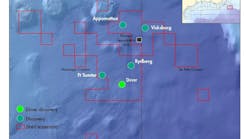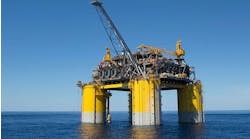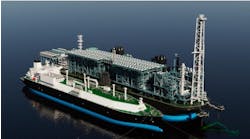Editor's note: This story first appeared in the November-December 2022 issue of Offshore magazine's first annual Offshore Oil and Gas Executive Perspectives Special Report.
By Ariana Hurtado, Editor and Director of Special Reports
Over the last few years, ESG went from a concept to a buzzword to a main staple in every company’s strategic planning—with major investments tied to projects and initiatives. Moreover, the “energy transition” transitioned to an “energy transformation” journey, as the industry realized it was a lengthier process and realistically was not a simple step from point A to B.
In September, Offshore interviewed Talos Energy’s Robin Fielder, executive vice president, low carbon strategy and chief sustainability officer, and João Henrique Rittershaussen, Petrobras’ production development director, to discuss their ESG initiatives and the energy transformation. These seasoned industry experts shared what they view as their company’s top 2022 achievements, their current decarbonization efforts and what their companies have planned for 2023.
OFFSHORE: What are your company’s top 2022 offshore oil and gas project accomplishments, milestones and/or year-end targets?FIELDER: In August of this year, we initiated our open water rig program, which will conduct several sequential operations into 2023. We’re excited about three deepwater exploitation prospects that we plan to drill as part of that program, all of which could be important contributors to future years’ production, and which would flow through Talos-operated infrastructure if successful. Additionally, we’re looking forward to spudding the appraisal well for Puma West later this year, which follows our 2021 sub-salt discovery well.
RITTERSHAUSSEN: For our 2022-2026 Strategic Plan, we maintain our strategy of investing in deepwater and ultradeepwater assets to ensure the sustainability of our production curve. Our focus continues to be on doubly resilient projects at low oil prices with low-carbon emissions.
This year we did important deliveries. FPSO Guanabara, for example, started operating in April. It is the first definitive system in the Mero Field, with a production capacity of 180 mbpd. In July, the unit started with gas reuse (flare out), which allowed increasing oil production and, as a result, in the same month, it reached peak production of around 70 mbpd with two producing wells.
By 2026, 14 new platforms are expected to start operating, and all FPSOs that will come into operation by 2025 are already contracted. The 15 platforms in the plan represent almost half of the total 37 units of this type to be installed worldwide in this period. In addition, the production estimate for 2026 is 3.2 million barrels per day, approximately 15% above current production.
OFFSHORE: What are your company's targets for FID and/or first oil for those projects?RITTERSHAUSSEN: In 2023, five new systems come into operation (Búzios 5, Malim 1 and 2, Mero 2 and Itapu). The company remains firmly committed to deliver the projects on time. These production units are in the final construction stage, concluding the integration and commissioning activities. The Búzios 5 and Marlim 2 platforms already left the Chinese shipyards for Brazil in July to complete the commissioning, inspection and acceptance tests. The well campaign for the five projects is in progress and proceeding according to their respective schedules and strategies, which ensures we will meet the deadline for increasing production (ramp-up) at these units. Regarding subsea systems, we highlight the Mero 2 and Búzios 5 projects, which will apply an integrated contract model (EPCI) for their scope of installation, and both are already contracted.
FIELDER: Talos is striving to be the energy company of the future, which we believe is an organization that can responsibly provide safe, reliable hydrocarbon production to satisfy society’s needs for decades to come while also utilizing its skill sets to advance large-scale decarbonization projects and helping to reduce emissions in a meaningful way.
We have businesses that are well positioned on both fronts. Our Upstream business in the Gulf of Mexico aims to grow production in one of the world’s safest and lowest emission regions, and we have set a stretch goal to reduce our own emissions intensity by 40% by 2025 from our 2018 baseline. Separately, our rapidly growing Carbon Capture and Sequestration (CCS) business has established a leadership position across the US Gulf Coast with multiple regional hub and point source projects with marquee partnerships.
RITTERSHAUSSEN: Our priority is to ensure that our production is competitive under energy transition scenarios in line with the Paris agreement. Therefore, we consider [it] essential to operate at low cost and low emissions, producing the necessary oil and gas and generating profits even in a context of market retraction, falling oil prices and carbon pricing.
It is important to note that all our investments must be profitable in our resilience scenario, with a long-term oil price of $35, that is, compatible with accelerated transition scenarios. In addition, our largest presalt fields, Tupi and Búzios, currently operate at less than 10 kg CO2e/boe, among the most carbon-efficient fields in the world (the world average emits more, 17 kg CO2e/boe, or 70% more emissions).
In 2021 we took on the challenge of reaching zero net operating emissions of greenhouse gases (GHG) within a period compatible with the Paris Agreement. This ambition adds to our basket of 10 sustainability commitments with a horizon of 2025 and 2030, six of which are related to the mitigation of GHG, including the reduction of emissions and methane intensity in E&P.
At the same time, we created a profitable diversification committee to assess new business opportunities in the energy transition.
OFFSHORE: What policies has your company put in place to help meet offshore ESG goals?FIELDER: Environmental responsibility, safety and strong ethics has always been an important part of Talos culture and a critical focus area for operating successfully offshore. We’ve formalized our ESG efforts top to bottom within the organization, beginning with expanding the board of directors’ oversight through the Safety, Sustainability and Corporate Responsibility Committee as well as establishing a multi-discipline employee-led ESG Committee. These frameworks ensure consistent oversight and reporting as well as broad participation from employees into our ESG efforts.
RITTERSHAUSSEN: Our ESG ambitions are supported by a set of policies and actions related to climate change mitigation; health, safety, and environment (HSE); social responsibility; and corporate governance.
For example, Petrobras’ 2022-2026 Strategic Plan predicts an investment of $1 billion in environmental enterprises in this period, focusing on technological innovations to decarbonize operations, develop modern fuels with renewable, sustainable and high-quality content, and developing skills for the future.
We also have commitments related to water resources, waste, biodiversity and social and environmental investments. Such commitments include a reduction of freshwater extraction, optimization of effluent treatment, minimization, reuse and disposal of waste in an environmentally sustainable way, and process and occupational safety.
The Strategic Plan for 2022-2026 consolidated the Carbon Neutral Corporate Program, which aims to accelerate the identification and development of the best solutions for decarbonization at the lowest cost, ensuring that the operational goals are achieved. Additionally, the program also includes some actions related to Scope 3, reaching the entire value chain (Scope 1, 2, and 3).
The program is supported by a dedicated decarbonization fund, with a $248 million budget for the five-year period.
Petrobras also increased the training of its employees on topics such as climate change mitigation and human rights, raising awareness and communicating internally the importance of achieving the ESG goals.
OFFSHORE: What 2022 offshore ESG achievement are you most proud of and why?
RITTERSHAUSSEN: In 2022 we beat our records for low-carbon intensity both upstream and downstream. In addition, we hired for the first time a credit line linked to sustainability commitments (Sustainability Linked Loans - SLL) in the amount of $1.25 billion, due in July 2027. The rates vary according to the fulfillment of three targets, two of which are for E&P: GHG emission intensity from E&P and methane emissions intensity from E&P, in addition to GHG intensity from refining. This reinforces our focus on decarbonizing our operations and expands our liability management strategy by diversifying the financing models, in line with the sustainability requirements increasingly present in the debt markets.
We are also proud to have surpassed the accumulated mark of 30 million tons of CO2 reinjected into the offshore environment, with the carbon capture, utilization and geological storage (CCUS) program. We strongly believe in the role of innovation not only for optimizing existing processes, but also to incorporate new technologies and low-carbon concepts into our projects and activities.
OFFSHORE: What decarbonization project(s) and/or technology will your company be focused on in 2023?FIELDER: We are highly focused on advancing our carbon capture and sequestration projects this year and next year, as well as continuing to look for new ways to expand our Low Carbon Solutions portfolio. With our current CCS projects, we are advancing front-end engineering and design work and are in various planning stages for stratigraphic evaluation wells, which will provide important data for us to submit within Class VI sequestration permit applications with the Environmental Protection Agency.
RITTERSHAUSSEN: We have more than 500 decarbonization opportunities mapped, in different stages of maturity. For 2023 our focus is on opportunities for operational excellence, notably in energy efficiency, reduction of flaring and reduction of methane losses, for example, fugitive emissions. Our gas utilization is already above 97%, with some assets operating above 99%. We already had significant reductions in methane emissions and continue to pursue new opportunities in these areas. In addition, we will maintain and propose the expansion of our investments in nature-based solutions.
OFFSHORE: The electrification of oilfield infrastructure has many sustainability benefits. What is your company's involvement with offshore electrification solutions?RITTERSHAUSSEN: Reducing emissions is a priority. At each project generation, Petrobras incorporates innovations that increase carbon efficiency. One example is the incorporation of the All Electric FPSO concept, which consists of electrifying as many equipment and applications as possible on an oil and gas production platform. This configuration is more efficient [because it] allows using less fuel and allows up to 20% reduction in GHG and pollutants.
OFFSHORE: What alternate power projects and technologies is your company prioritizing in 2022 and 2023?RITTERSHAUSSEN: In the ultradeepwater offshore environment, there are particular technological challenges to supply our assets with alternative electricity. There are a few maturing options, involving renewable gas-fired thermoelectric generation with CCUS, which still has technological and economic gaps to be solved, but the company has invested its human capital to make these projects viable.
It should be noted that Petrobras has been operating in the electricity market for over a decade, supplying thermal energy to stabilize the Brazilian electricity grid, which has 85% intermittent and seasonal renewables. Our profitable diversification committee has been evaluating opportunities associated with the energy transition to renewable energies, and Petrobras continues to plan and execute several actions to expand the supply of sustainable fuels.
OFFSHORE: Which new or innovative offshore technology has impressed or interested you the most?RITTERSHAUSSEN: In addition to the all-electric concept mentioned above, we have been working on several other fronts, like our Carbon Capture, Utilization and Storage (CCUS) program in the presalt fields, which has been recognized as the largest in the world in operation, in volume of CO2 reinjected annually. This result demonstrates Petrobras’ capacity for innovation, engineering and operation. The solution developed by Petrobras is a first in ultradeepwaters.
Another highlight is a technology patented by Petrobras which is already in the contracting phase: HISEP. It will allow separating, pumping and reinjecting CO2-rich gas still at the bottom of the sea. In addition to the positive effects of simplifying the platform, as this gas will not be processed on the surface, the separation and injection of CO2 will help us extract more oil. HISEP has a positive impact on the unit’s GHG emissions intensity, as it reduces emissions from gas processing.
OFFSHORE: What is the path forward for the oil and gas industry?RITTERSHAUSSEN: A world aligned to Paris is not a world without oil for several decades. However, it must be a priority for every player in this industry to quickly reduce the emissions associated with production, which are significant worldwide, while providing affordable energy that is necessary for a just transition. Clearly our main focus is to make sure we are producers of low-carbon, low-cost oil, compatible with a world in fast transition.
We do understand, however, that there is a transition in place, with the markets for electricity and sustainable fuels estimated to grow significantly in the upcoming decades, albeit with profiles and speed different on every region. Each company will have different paths depending on the competitiveness of their oil reserves, markets and competences. We have already announced our commercial plans for advanced biofuels and are advancing on other business opportunities associated with the transition to a low carbon economy.
OFFSHORE: What advice do you have for the next generation of professionals entering or considering entering the industry?RITTERSHAUSSEN: The energy sector is undergoing a global and inevitable transition. This transition will be gradual, and multiple decarbonization solutions will coexist. Every company and every professional must make their contribution to the energy transition challenge. In the oil and gas industry, the challenge is to be part of the responsible supply that will meet the future demand for oil and gas, with low emissions from operation and low production costs. As a technology-intensive sector, which requires innovation to develop its projects, it is natural for research and innovation to be the engines that will ensure an adequate supply of energy in the future. The whole world aspires to a future with abundant, clean and cheap energy.










